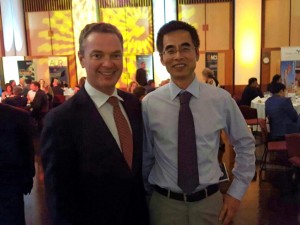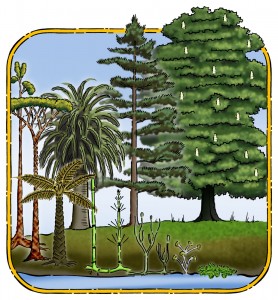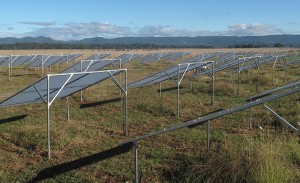- About
- Members
- Join
- Member log in
- Membership Renewal
- Member directory
- Life Members
- ASPS Life Member Professor Graham Farquhar
- ASPS Life Member Associate Professor Hendrik (Hank) Greenway
- ASPS Life Member Dr Marshall (Hal) D Hatch
- ASPS Life Member Dr Paul E Kriedmann
- ASPS Life Member Dr Mervyn Ludlow
- ASPS Life Member Emeritus Professor Rana Munns
- ASPS Life Member Conjoint Professor Christina E Offler
- ASPS Life Member Professor (Charles) Barry Osmond
- ASPS Life Member Emeritus Professor John W Patrick
- ASPS Life Member Dr Joe Wiskich
- Corresponding Members
- Elected Fellows
- Events
- Awards & Funding
- Employment
- Publications
- Research
- Teaching
- Menu
Plasmodesmata in rice and Setaria: A comparison of symplastic transport mechanisms in C3 and C4 plants
18 April 2016
Article by Florence Danila: Recipient of the ComBio 2015 ASPS Student Poster Prize
A large majority of the human population depends on rice (Oryza sativa) for survival. Rice production needs to increase by 50% to support a higher demand for food forecasted over the next 35 years due to an increasing human population. Traditional breeding can only increase rice yield by 1% per annum. Switching the less efficient C3 photosynthetic system of rice to use a more efficient C4 photosynthesis, would theoretically increase productivity by 50%. The aim of the C4 Rice Consortium is to add features of C4 photosynthesis to the C3 plant, rice. Therefore, it is essential to know whether rice can support the expected increase in metabolite flux between the leaf mesophyll (M) and bundle sheath (BS) cells after all the C4 biochemistry has been installed. The main pathway for metabolite flux is symplastic, i.e. via the plasmodesmata (PD) connecting M and BS cells. Comparison of the symplastic transport mechanisms between the C3 monocot crop, rice, and the C4 plant, Setaria viridis was done by looking at the PD density and pit field distribution between the M and BS cells. Electron microscopy and 3D immunolocalisation showed that Setaria (C4) has higher PD density and higher pit field area coverage on M/BS cell interface than rice (C3). Establishing the numerical difference in terms of PD connections between C3 and C4 plants is not only relevant for the C4 Rice Project but also in plant transport and modelling studies.
Acknowledgements:
ARC Centre of Excellence for Translational Photosynthesis (Research School of Biology, Australian National University, Canberra, Australia). International Rice Research Institute (Laguna, Philippines). CSIRO Agriculture (Canberra, Australia).
KILLING FUNGAL PATHOGENS – DETERMINING THE MODE OF ACTION OF AN ANTIFUNGAL DEFENSIN
06 April 2016
Article by JENNIFER PAYNE: Recipient of the ComBio 2015 ASPS Student Poster Prize
Plants can’t run and and hide from their enemies. They are rooted to the spot and consequently have developed sophisticated defence mechanisms to shield them from potential invaders. Unlike animals they don’t have an adaptive immune system and rely instead on physical barriers such as waxy cuticles, secondary metabolites and innate immunity proteins for protection against potential microbial pathogens. Plant defensins, are a crucial part of this innate immune system. They are small, stable, cysteine-rich proteins that are produced by all plant taxa and most plant tissues. NaD1 a plant defensin from the ornamental tobacco Nicotiana alata, has potent antifungal activity against a range of serious plant pathogens that can devastate crop yields and we have been exploring its potential application in crop protection. NaD1’s antifungal mechanism is complex involving multiple steps, beginning with specific interaction with the fungal cell wall, followed by disruption of the plasma membrane and entry into the cytoplasm where it initiates cell death. Unlike most antifungal molecules, NaD1 requires an intact cell wall for its antifungal activity. The fungal cell wall is unique to fungi, creating an ideal selective target for new generation fungicides. It is composed of three layers; an outer glycoprotein layer, a β-1,3-glucan layer and a chitin layer immediately adjacent to the plasma membrane. Direct binding assays and chemical and genetic alteration of the thickness of the cell wall layers revealed that NaD1 binds with a higher affinity to chitin than β-1,3-glucan. This led to the hypothesis that NaD1 might be directed through the wall and onto the plasma membrane by an affinity gradient, a novel mechanism for passage through the cell wall. Once through the wall, NaD1 must pass through the plasma membrane to enter the cytoplasm and kill the fungal cell. The interaction between NaD1 and the membrane was studied using liposomes and bilayers of different lipid composition together with dual polarisation interferometry. This revealed that; NaD1 only interacts with membranes containing phosphatidylinositol 4, 5-bisphosphate, the membrane becomes disordered upon NaD1 binding, and NaD1 does not dissociate from the membrane after binding (Payne et al 2016). These data supported the work of Poon and colleagues (2014) who reported that NaD1 and phosphatidylinositol 4, 5-bisphosphate form an elegant arc shaped oligomer and highlighted a new mechanism for membrane disruption by an antimicrobial peptide.
References:
Payne, J. A., Bleackley, M. R., Lee, T. H., Shafee, T. M., Poon, I. K., Hulett, M. D., . . . Anderson, M. A. (2016). The plant defensin NaD1 introduces membrane disorder through a specific interaction with the lipid, phosphatidylinositol 4,5 bisphosphate. Biochim Biophys Acta, 1858(6), 1099-1109. doi:10.1016/j.bbamem.2016.02.016
Poon, I. K., Baxter, A. A., Lay, F. T., Mills, G. D., Adda, C. G., Payne, J. A., … Hulett, M. D. (2014). Phosphoinositide-mediated oligomerization of a defensin induces cell lysis. eLife, 3, e01808. http://doi.org/10.7554/eLife.01808
For more information email: ja2payne@students.latrobe.edu.au (La Trobe University, Melbourne Victoria Australia)
Science Meets Parliament 2016
06 April 2016
| By Professor Yong-Ling Ruan at The University of Newcastle |
On behalf of Australian Society of Plant Scientists, I joined Science Meets Parliament (SMP) on the 1st and 2nd of March, 2016 in Canberra. The SMP aims to provide scientists unique opportunities to build mutual understanding and connections between scientists and parliamentarians and to better understand the policy making process connecting science and innovation that underpins Australia’s economic, social and environmental wellbeing.
|
Professor Yong-Ling Ruan, ASPS representative, and Hon Christopher Pyne, MP, and Minister for Industry, Innovation and Science at the Science Meets Parliament 2016 at the Great Hall of the Australian Parliament House in Canberra on the 1 March 2016. |
Day 1 of the SMP started with an opening address given by Professor Brian Schmidt (AC, Nobel Laureate and Vice Chancellor of ANU) at the Hotel Realm. Prof Schmidt analysed a broad aspects of Australian Science and offered a few ‘tips’ on how to talk to politicians. This was followed by a vivid discussion and debate on ‘How to turn your science into news’, presented by Kylie Walker (Australian Academy of Science), Paul Bongiorno (Network Ten) and Alison Carabine (ABC radio). The meeting continued with an ‘Interactive session’ on rehearsing for parliamentary meetings and concluded with a Gala dinner at the Great Hall in Parliament House where key note speakers, the Hon Christopher Pyne MP, (Minister for Industry, Innovation and Science) and the Hon Bill Shorten MP (Leader of the Opposition) addressed the audience outlining their policies and visions for the future of Australian science.
Day 2 featured face-to-face group meetings in Parliament House with Ministers, Parliamentary Members and Senators. Their were concurrent sessions on Science and Politics delivered by past and present Federal Chief Scientists, Professors Ian Chubb and Alan Finkel, respectively, as well as Aidan Byrne (ARC CEO Professor) and Senator Kim Carr (Shadow Minister for Higher Education, Research, Innovation and Industry).
The two-day event proved to be a very rewarding experience. It helped to better understand and appreciate the process of formulating science-related policies and decisions developed at the government level. It provided a unique opportunity to network with politicians, journalists and fellow scientists while advocating plant science to the broader community. To the latter, I attached here a photo with the Science Minister Chris Pyne at the Gala diner following his keynote speech and our informal discussion.
Email: yong-ling.ruan@newcastle.edu.au
Leaf respiration in a warmer world is substantially lower than previously thought
22 March 2016
By Sebastian Pfautsch
ASPS Representative ‘Environment and Ecophysiology: Global Change’
Hawkesbury Institute for the Environment, Western Sydney University
Every year plants respire about 64 Gt CO2 back into the atmosphere. That is six times as much as released from burning fossil fuels. Obviously, small proportional changes in the respiratory flux can result in dramatic changes in atmospheric CO2 concentrations and associated warming effects.
Plant respiration (R) is positively correlated to temperature (T). Plant scientists have believed that R will accelerate under global warming, generating a feed-forward loop where plant-respired CO2 leads to even faster rates of warming, that lead to even greater fluxes of R and so on. Clearly, this scenario, where plants are responsible for faster rates of global warming is a scary one. Should plants be put into the limelight of being irresponsible climate sinners? Have plants worked out an evil plan to overthrow Homo sapiens? Are we all working for the enemy?
Rest assured, the short answer is no. The slightly longer answer, according to plant ecologist Peter Reich is “that we have no silver bullet to stop global warming, but recent research on the temperature-R relationship provides a silver lining in an otherwise dark sky”.
Recently Peter published new research findings on plant R in Nature (http://www.nature.com/nature/journal/vaop/ncurrent/full/nature17142.html ). He and his team grew 10 North American tree species for five years in the field and measured an insane amount of R-to-T response curves of leaves. Trees were grown under ambient and warmed (+3.4 °C) conditions with and without canopy cover of dominant trees. When leaves of ambient trees were exposed to +3.4 °C warming for a short time, their rate of R increased by 23% compared to unwarmed leaves.
However, when R was measured in leaves that were constantly warmed, they respired 80% less than those plants that experienced only short-term warming. This indication of long-term acclimation of R to higher T has large implications for global simulation models that – until now – have falsely assumed that R increases exponentially when T is rising. Consequently, these models have grossly overestimated atmospheric concentrations of CO2 and associated rates of global warming.
Independent of the research in North America, two other studies have emerged that point in the same direction. A global team, spearheaded by colleagues from ANU (Heskel et al., 2016, published in PNAS) found that R did not increase exponentially as T rose along an environmental gradient reaching from the artic to equatorial biomes and covering 231 plant species. Most importantly, the shape of the response curve of R-to-T was similar for all species, pointing to a universally applicable sensitivity of leaf metabolism to T. Earth system modellers must have a field day as these results make life so much easier…
The second study I’d like to point out is the work by John Drake and colleagues, accepted for publication in New Phytologist. This work brings R-to-T responses home to Eucalyptus trees. 12 Forest Redgum trees were grown in 10 m tall whole-tree chambers in Richmond, of which half tracked ambient temperatures, the other half ambient +3 °C warming. Instrumentation of the chambers allowed John to track gas exchange of the trees on a day-to-day basis at high temporal resolution.
Results from these Redgums agreed with Peter’s work on North American trees. R did not increase with warming. Furthermore, the Redgums responded to warming by decreased photosynthetic carbon assimilation. This means that – although indirectly – warming may increase atmospheric CO2 concentrations, but not due to increased R rather than decreased assimilation of C. In the experiment this led ultimately to a small increase in the ratio of R-to-photosynthesis, but only during heatwaves.
John says “these gum trees happily adjusted their physiology to cope with warming during most conditions, but heat waves were different. The gums shut their stomata and waited out the heat, but in the process they lost a lot of C to respiration without gaining any via photosynthesis”. In a global warming perspective this means that higher atmospheric CO2 concentrations could be the result of decreased uptake of CO2 by trees during the more frequent and intense heat waves predicted for our future in Australia.
The capacity of plants to acclimate to higher temperatures without exponentially increasing R is great news for the modelling of the earth system. As Peter puts it, acclimation of R to temperature only represents “a delay in the race to the climate change cliff”. However, we must consider that ecosystem R is much more than leaf R. At least John’s paper reports R of the woody proportion of trees (R is slightly increasing with warming). Leaf R represents roughly 50% plant R, with fine roots being responsible for the majority of the other half. We know little about acclimation of R in fine roots.
We know even less of acclimation of R in soil microbial biomass. And on a ecosystem scale consider that: while under hot and dry conditions plants would close stomata, leading to reduced uptake of CO2 while R remains relatively constant, soil microbial activity would slow down, autotrophic R would decrease and soils would retain more C. How does that affect atmospheric concentrations of CO2?
It gets complicated really quickly if we leave experimental units and enter the real world where plants have to deal with competition for resources (e.g. light, water, nutrients), grow fast or slow, tolerate shade more or less, age, etc. And on top of all that, even one of the world’s most distinguished plant ecologist admits that we don’t even know how acclimation exactly modifies enzymatic and biochemical processes. Nevertheless, pushing the boundaries of our understanding of R-to-T responses remains important work.
The seminal work of Owen Atkin and Mark Tjoelker 13 years ago (published in TiPS) defined the current framework of leaf acclimation. The three most recent studies about R-to-T responses and their implications to the earth system are tribute to an ever-progressing understanding of the effects of global warming on the natural world.
And besides all the great results, the work by Reich, Heskel and Drake and their colleagues is proof of the importance of well-funded, long-term and field-based research programs – a type of plant science that is pushed towards extinction. So, are plants winning after all? Take a deep breath and … respire.
38th New Phytologist Symposium: Colonization of the terrestrial environment 2016
20 January 2016
38th New Phytologist Symposium:
Colonization of the terrestrial environment 2016
25-27 July 2016, Bristol, UK
Travel grant submission deadline: Thursday 21st April 2016
Poster abstract submission deadline: Thursday 19th May 2016
The purpose of this symposium is to explore the contribution that plants and mycorrhizal fungi made to the colonization of the terrestrial environment. Building on the success of the 25th New Phytologist Symposium, the focus will be on exploring current uncertainties in four major themes:
1) Interrelationships;
2) Anatomy – developmental genetics;
3) Refining biogeochemical models to take account of the role of plants and fungi; and
4) Anatomy and physiology of early land plants – what can we learn from extant species?
The meeting will take place over three days in Bristol, UK. There will be a number of invited and selected talks (chosen from submitted poster abstracts). There will also be dedicated time for a poster session and conference dinner.
Keynote speakers:
Liam Dolan, University of Oxford, UK; Ned Friedman, Harvard University, USA; Tim Lenton, University of Exeter, UK
37th New Phytologist Symposium: Plant developmental evolution
20 January 2016
37th New Phytologist Symposium:
Plant developmental evolution
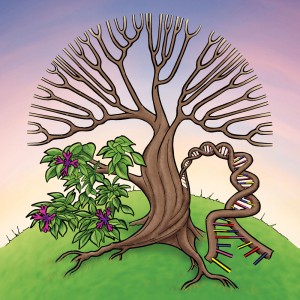
Beijing, China
Travel grant submission deadline: Thursday 25th February 2016
Poster abstract submission deadline: Thursday 17th March 2016
The relatively new field of plant evolutionary-developmental biology (‘evo-devo’) seeks to understand how and why plant morphological characters have evolved to produce the tremendous diversity of form in living plants. This meeting will draw together researchers in plant evo-devo for exchange of ideas, current research, and discussion of future directions for the field.
Sessions:
floral development; vegetative meristems, leaves, and inflorescences; plasticity and life history evo-devo; selected poster abstract talks.
Eighteen leading scientists will speak at the Symposium. We hope that this will stimulate focused discussion and the exchange of ideas at what will be a relatively small (around 120 delegates) and informal meeting. There will be a poster session, selected talks, discussion and a conference dinner.
Keynote speakers:
Beverley Glover, University of Cambridge, UK; Mark Rausher Duke University, USA; Miltos Tsiantis, Max Planck Institute for Plant Breeding Research, Germany.
Ninth Australian Conference on Grassland Invertebrate Ecology
15 January 2016
Ninth Australian Conference on Grassland Invertebrate Ecology
4-7 April 2016, Western Sydney University, Australia
The conference focuses on the biology, ecology and management of both pest and beneficial invertebrates in native and introduced grasslands including pastures, pasture/crop rotations and turf.
The Conference (grassbugs.com.au) will be hosted by the Hawkesbury Institute for the Environment at the historic Hawkesbury campus of Western Sydney University. The campus is nestled at the foot of the Blue Mountains and has been a hub of agricultural research and training since 1891. Grassland research, in particular, has featured prominently at the site with modern Australian grasses first used and developed on the Hawkesbury campus in the 1920s. The Conference will be held over three days including a half day field trip to the Royal Botanic Gardens in the Blue Mountains.
Report from Dr Samantha Grover, Plant Nutrition Trust Award recipient 2015
08 January 2016
5th International Symposium on Soil Organic Matter, Göttingen, Germany, September 20-25th
A whole week of soil organic matter! While many Europeans commented that it was a long way to come for a conference, the nine Australians lucky enough to attend SOM2015 all agreed that we found it thoroughly worthwhile. On the pre-conference field trip, Brian Wilson, Samantha Grover and a dozen other scientists visited peatlands under a range of agricultural uses and had fun flitting back and forth across the former border between East and West Germany. Schnapps tasting at a former convent ended the day but set the scene for the conference proper, which featured different local beers during the poster sessions every evening. Lynne Macdonald, Mark Farrell, Gaelle Ng, Tom Baker, BP Singh, Bhawana Bhatta and Jessica Ernakovich joined Brian Wilson and Samantha Grover to present a wide range of the SOM research from Australia. Outputs from the National Soil Carbon Program were abundant. The Australian contingent joined delegates from more than 50 countries, who presented 161 talks over four days, selected from more than 600 submitted abstracts. The bar was set high, with opening keynote addresses from Rattan Lal and Johan Six. All agreed that this high standard was maintained and the coffee (and beer) breaks were abuzz with animated conversation. Dr Grover’s talk on the effects of lime on the mineralisation of soil organic matter attracted considerable interest and connections were established with two authorities in this area. Ongoing research on peat soils was also strengthened by the first face-to-face meeting between Samantha Grover and Anna Normand, a PhD student from the University of Florida whom Dr Grover co-supervises. The next conference baton was passed on to Jennifer Dungait from Rothamstead Research, which will host the 6th SOM symposium in 2017. A post-conference workshop on SOM fractionation will result in a comparative trial of fractionation methods from laboratories around the world, with Lynne Macdonald accepting the trial soils to contribute CSIRO’s methodology to the study.
After the conference Samantha visited Dr Cordula Vogel and Professor Karsten Kalbitz at Dresden Technical University and gave a splendid talk to their Soil Science and Site Ecology group. Potential collaborations were discussed, a joint project proposal drafted and relationships between the two groups were even further strengthened. The valuable contribution from the Plant Nutrition Trust was well acknowledged in all presentations and it helped to attract matching funding from La Trobe University.
Samantha Grover and Brian Wilson with colleagues at a remnant of the fence dividing East and West Germany on the SOM2015 pre-conference field trip.
Smokey Waters wins the 2015 Goldacre Award
17 November 2015
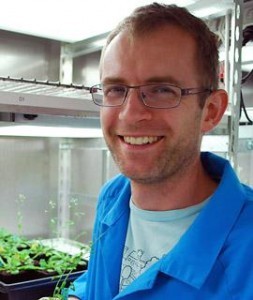 Mark Waters hails from the southern regions of the UK. He went to school in Bedford and was fortunate to study Biological Sciences at the University of Oxford. Here he nurtured his curiosity towards understanding plant growth and development after becoming inspired by a first year practical class on photosynthesis. After completing his PhD at the University of Nottingham studying plastid stromules with Kevin Pyke, he returned to the Department of Plant Sciences at Oxford for a post-doc stint with Jane Langdale. There he investigated the transcriptional regulation of chloroplast development, picking up essential skills in genetics and molecular biology. Next Mark moved to Australia in 2010 having been attracted to the impressive reputation of the ARC Centre of Excellence in Plant Energy Biology at the University of Western Australia (UWA). He joined Steve Smith’s group to explore the nascent field of karrikin signalling in plants.
Mark Waters hails from the southern regions of the UK. He went to school in Bedford and was fortunate to study Biological Sciences at the University of Oxford. Here he nurtured his curiosity towards understanding plant growth and development after becoming inspired by a first year practical class on photosynthesis. After completing his PhD at the University of Nottingham studying plastid stromules with Kevin Pyke, he returned to the Department of Plant Sciences at Oxford for a post-doc stint with Jane Langdale. There he investigated the transcriptional regulation of chloroplast development, picking up essential skills in genetics and molecular biology. Next Mark moved to Australia in 2010 having been attracted to the impressive reputation of the ARC Centre of Excellence in Plant Energy Biology at the University of Western Australia (UWA). He joined Steve Smith’s group to explore the nascent field of karrikin signalling in plants.
Named after the local Noongar word for smoke, karrikins are small molecules produced by burning vegetation, and are thus prevalent in the post-bushfire environment characteristic of Australia. The seeds of many plant species germinate upon exposure to plant-derived smoke, and Gavin Flematti at UWA identified karrikins as one of the bioactive compounds in 2004. The karrikin story therefore has a decidedly Australian flavour.
Genetic screens for karrikin-insensitive mutants of Arabidopsis thaliana led to the major discovery that formed the basis for Mark’s 2015 Goldacre Award: the identification and characterisation of the karrikin receptor protein KAI2. This work, published in Development in 2012, provided strong evidence that all plants, not just those adapted to fire-prone environments, possess the key machinery for detecting karrikins.
KAI2 belongs to a family of hydrolase-type proteins that also incudes DWARF14, the receptor for the strigolactone class of plant hormones. Strigolactones influence several developmental processes, most notably shoot branching. Karrikins and strigolactones are chemically similar, as both compounds possess the same “butenolide” structure that is essential for bioactivity. Mark’s research has demonstrated that KAI2 and DWARF14 are structurally similar proteins with quite different physiological functions. As a result, his work has positioned karrikins as abiotic plant growth regulators that are distinct from strigolactones, each having a respective receptor protein with different ligand specificities (Waters et al. 2012, Scaffidi et al. 2013, Scaffidi et al. 2014).
Some of Mark’s more recent work has described the evolutionary conservation of KAI2-dependent signalling in plants. KAI2-type proteins can be traced back to the algal ancestors of land plants, and crucially they are functionally conserved between lycophyte ferns and angiosperms, which diverged over 400 million years ago (Waters et al., 2015). This finding implies that KAI2 is fundamentally important to plant development, a fact borne out by the dramatic seed germination, seedling growth and leaf development phenotypes of KAI2-deficient mutants. In light of the fact that most plants do not encounter karrikins under natural conditions, it is possible that KAI2 has evolved not to perceive smoke, but instead to detect related butenolide compounds that remain to be discovered.
Dr Waters will explore the interface between chemical genetics and molecular biology and hopes to identify new butenolide compounds. He aims to dissect plant hormone interaction networks involved in plant development and perhaps exploit the KAI2 signalling system for crop improvement strategies. Mark and his colleagues have instigated a smoking hot area of research discovery into such an amazing chemical rich in Australian ecological significance.
Contact:
Email: mark.waters”at”uwa.edu.au
URL: http://www.uwa.edu.au/people/mark.waters
Twitter: watersmt
Selected references
- 1. Waters, MT*, Nelson, DC, Scaffidi, A, Flematti, GR, Sun, YK, Dixon, KW, & Smith, SM (2012). Specialisation within the DWARF14 protein family confers distinct responses to karrikins and strigolactones in Arabidopsis. Development, 139, 1285–1295. http://doi.org/10.1242/dev.074567 (*corresponding author)
- 2. Scaffidi, A*, Waters, MT*, Ghisalberti, EL, Dixon, KW, Flematti, GR, & Smith, SM (2013). Carlactone-independent seedling morphogenesis in Arabidopsis. The Plant Journal, 76, 1–9. http://doi.org/10.1111/tpj.12265 (*Joint first authors)
- 3. Scaffidi, A, Waters, MT, Sun, YK, Skelton, BW, Dixon, KW, Ghisalberti, EL, et al. (2014). Strigolactone hormones and their stereoisomers signal through two related receptor proteins to induce different physiological responses in Arabidopsis. Plant Physiology, 165, 1221–1232. http://doi.org/10.1104/pp.114.240036
- 4. Waters, MT*, Scaffidi, A, Moulin, SLY, Sun, YK, Flematti, GR. & Smith, SM (2015). A Selaginella moellendorffii ortholog of KARRIKIN INSENSITIVE2 functions in Arabidopsis development but cannot mediate responses to karrikins or strigolactones. Plant Cell, 27, 1925–1944. http://doi.org/10.1105/tpc.15.00146
(*corresponding author)
Australian Society of Plant Scientists welcomes new submissions for Phytogen blog
09 November 2015
Dear Plant Scientists,
The Australian Society of Plant Scientists (ASPS) and Website & Communications Sub-Committee welcome your submissions to our Phytogen blog.
ASPS publishes the Society newsletter Phytogen to promote plant science and outreach to members and the general public. Phytogen is currently a live blog and is periodically sent to our members via email.
We believe that Phytogen is a valuable vehicle for communicating new ideas, recent professional experiences, and events, while promoting our Society and plant biology in general. Current and relevant content is critical to achieve these goals.
How can you help? We are continuously seeking for relevant content from Society members, including researcher profiles, conference highlights, government policy development, agricultural and academic innovation, biological discoveries and conservation, national and international outreach activities or description of a new breakthrough technology.
ASPS will continue to enhance the exposure of Australian plant science through effective communication to a general audience. We encourage you, especially our HDR students (e.g. MSc/PhD) and Early Career Researchers to contribute to Phytogen and our social media networks (Facebook or twitter).
ASPS would like to sincerely thank Conjoint Professor Tina Offler for her long-standing role as the chief editor of Phytogen. Tina will continue as co-editor and provide professional mentorship to support the new chief editor of Phytogen; Dr. Chris Cazzonelli.
We welcome you to contact Chris (c.cazzonelli@westernsydney.edu.au) to discuss article ideas or submit your story for publication in Phytogen.
Regards,
Chris.
Recent Posts
Tags
Archives
- June 2025
- May 2025
- April 2025
- March 2025
- February 2025
- January 2025
- December 2024
- November 2024
- October 2024
- September 2024
- August 2024
- July 2024
- June 2024
- May 2024
- April 2024
- February 2024
- January 2024
- November 2023
- October 2023
- September 2023
- August 2023
- July 2023
- June 2023
- May 2023
- April 2023
- March 2023
- February 2023
- December 2022
- November 2022
- October 2022
- September 2022
- August 2022
- July 2022
- June 2022
- May 2022
- April 2022
- March 2022
- February 2022
- January 2022
- December 2021
- November 2021
- October 2021
- September 2021
- August 2021
- July 2021
- June 2021
- April 2021
- March 2021
- February 2021
- January 2021
- December 2020
- November 2020
- October 2020
- September 2020
- August 2020
- July 2020
- June 2020
- May 2020
- April 2020
- March 2020
- February 2020
- January 2020
- December 2019
- November 2019
- October 2019
- September 2019
- August 2019
- July 2019
- June 2019
- May 2019
- April 2019
- March 2019
- February 2019
- January 2019
- December 2018
- November 2018
- October 2018
- September 2018
- August 2018
- July 2018
- June 2018
- May 2018
- April 2018
- March 2018
- February 2018
- January 2018
- December 2017
- November 2017
- October 2017
- September 2017
- August 2017
- July 2017
- June 2017
- May 2017
- April 2017
- March 2017
- February 2017
- January 2017
- December 2016
- November 2016
- October 2016
- September 2016
- August 2016
- July 2016
- June 2016
- May 2016
- April 2016
- March 2016
- February 2016
- January 2016
- December 2015
- November 2015
- October 2015
- September 2015
- August 2015
- July 2015
- June 2015
- May 2015
- April 2015
- March 2015
- February 2015
- January 2015
- December 2014
- November 2014
- October 2014
- September 2014
- August 2014
- July 2014
- June 2014
Copyright 2017 Australian Society of Plant Scientists Disclaimer & Privacy
Website by Michael Major Media

